一、前言:在本人看着群里的大佬纷纷分享自己的文章和一些运维思路,深知只有用出来,写出来,分享出来,跟大家一起交流,这个程序和学习到的新知识才算真正掌握了。在这里非常感谢王印王老师@弈心、朱嘉盛老师@朱嘉盛以及群里的各位大佬不遗余力地分享着自己的文章。针对python的学习主要源于他们的专栏。
二、实验背景:
前一段时间,机房刚刚建完,但是弱电做的网线不太行,出现两次网线问题,这不是要了命了么。领导说,想办法如果交换机网线出问题了你得能知道。我想说,咱们用个运维平台不行吗,我又想我们今年手里的服务器资源只剩下4核,6G了。
行,那就写个脚本吧。本次实验以H3C设备为基础。
就是说写一个只要接口状态发生变化就能有邮件通知你,而且还有excle作为佐证。
我认为本次实验仅仅适用于十几二十台小环境的网络。(而且有点钱上个平台不比嘛强)
三、需求分析
首先首次使用脚本之后,excle里工作表收集的都是当前所有设备的UP的接口。

工作簿底下的工作表的是所有设备,以命名+IP的形式存在。

然后如果有一个接口的状态出现了变化,只要有变化,Link这一列对应的状态就会变色,还会发邮件以工作簿为附件。


如果你是就想人为规划断开这个接口,不是链路的损坏,那么在下次执行这个脚本的时候,不是UP接口就不存在了。

如果这个接口从ADM状态又回复为UP,那么也会发邮件,并且携带工作簿为附件。


最后设置成1分钟执行一次,放在服务器里。
每次执行程序只会维护第一次执行程序输出的这一张表,所以不用担心文件太多。
三、代码分析
3.1完整代码
先上完整代码,然后再进行分析。
#coding=gbk
importre
importsmtplib
importthreading
importtime
fromemail.mime.applicationimportMIMEApplication
fromemail.mime.multipartimportMIMEMultipart
fromemail.mime.textimportMIMEText
frompprintimportpprint
fromqueueimportQueue
fromnetmikoimportConnectHandler
fromopenpyxl.reader.excelimportload_workbook
fromopenpyxl.workbookimportWorkbook
fromopenpyxl.stylesimportPatternFill,Border,Side,Font
threads=[]#用于多线程
ip_list=open('ip_file.txt')#IP地址先行放入文件中
dims={}#用于对工作表中自动设置最大行宽
content=""#用于输出在邮箱中的内容
defssh_seesion(ip,ouput,):
globalcontent,sheet
#这几个列表是写入工作表的先行条件,也就是工作表的每一列,先把想写入工作表的每一列的内容写入列表,然后再遍历列表把内容写入工作表
interface_list=[]
link_list=[]
speed_list=[]
description_list=[]
connection_info={'device_type':'hp_comware',
'ip':ip,
'username':'xxxxx',
'password':'xxxxxx'}
withConnectHandler(**connection_info)asconn:
output=conn.send_command("displayinterfacebrief",use_textfsm=True)
sysname=conn.send_command('displaycurrent-configuration|includesysname')
name=re.search(r's+S+s+(S+)',sysname).groups()[0]
#pprint(output)
try:
sheet=wb[name+'_'+ip]#调用自己的那一张表
#先给逼删了
column_B=sheet['B']
foriincolumn_B:
#print(i.value)
ifi.valuenotin('Link','UP'):
num=re.search('d+',i.coordinate).group()#找到需要删的那一行
print(num)
sheet.delete_rows(int(num))
except:
pass
#取出接口up的
foriinoutput:
ifi.get('link')=='UP':
interface_list.append(i.get('interface'))
link_list.append(i.get('link'))
speed_list.append(i.get('speed'))
description_list.append(i.get('description'))
#判断这次interface跟上次也就是表格里的有没有区别以是否是UP的为前提不是UP的或者多了UP的或者少了UP的只要变化就要被记录
ifstr(name+'_'+ip)inwb.sheetnames:#如果这个表存在就让里原本有的接口进入列表
sheet_pre=wb[name+'_'+ip]
column_A=sheet_pre['A']#取出以前的表的第一列
sheet_pre_A1=[i.valueforiincolumn_A]
sheet_pre_A1.remove('Interfaces')#遍历第一列的时候会有抬头也就是Interfaces'需要把这个去掉
#print(sheet_pre_A1)#sheet_pre_A1里是上一次表格里有的接口列表
#print(interface_list)#interface_list里是这一次想放入表格里的UP的接口的列表
#取出两个列表的差集,这个差集是现在UP的和表里的差集
sheet_dif=list(set(sheet_pre_A1)^(set(interface_list)))#把两个表中变化的接口放入sheet_dif这个列表里
print(sheet_dif)#至此有变化的且不是UP的接口就进入列表了
iflen(sheet_dif)!=0:#如果这个列表里有数据就发邮箱
content=content+f"{name}的{str(sheet_dif)}接口发生了变化
'"#配合发邮件的
foriinoutput:#为了把差集的接口情况写入列表
forpinsheet_dif:
ifp==i.get('interface')andi.get('link')!='UP':#找到这个不是UP的接口各种情况还写进去
interface_list.append(i.get('interface'))
link_list.append(i.get('link'))
speed_list.append(i.get('speed'))
description_list.append(i.get('description'))
content=content+i.get('interface')+'接口由UP变成了'+i.get('link')+'
'
elifp==i.get('interface')andi.get('link')=='UP':
content=content+i.get('interface')+'接口UP了'+'
'
font=Font(name="微软雅黑",bold=True)#字体加粗
yellowFill=PatternFill(start_color='FFFF00',end_color='FFFF00',fill_type='solid')#黄色
thin_border=Border(left=Side(style='thin'),right=Side(style='thin'),top=Side(style='thin'),
bottom=Side(style='thin'))#有边框
SpringGreen=PatternFill(start_color='3CB371',end_color='3CB371',fill_type='solid')#黄色
ifstr(name+'_'+ip)inwb.sheetnames:#如果表格存在直接往里写
row_numbers=list(range(2,len(output)+2))#只能从第二行开始
forinterface,rowinzip(interface_list,row_numbers):
sheet.cell(row=row,column=1,value=interface)
forlink,rowinzip(link_list,row_numbers):
sheet.cell(row=row,column=2,value=link)
forspeed,rowinzip(speed_list,row_numbers):
sheet.cell(row=row,column=3,value=speed)
fordescription,rowinzip(description_list,row_numbers):
sheet.cell(row=row,column=4,value=description)
#往里写完之后查看B1这列然后找到不是UP的给赋值绿色
column_B=sheet['B']
foriincolumn_B:
#print(i.value)
ifi.valuenotin('Link','UP'):
print(i.coordinate)#查找到接口有问题的坐标
sheet[i.coordinate].fill=SpringGreen
else:#如果表格不存在则创建表格
sheet=wb.create_sheet(name+'_'+ip)#这里的sheet相当于JT-6-1F-DAS-1这个表格
columns=['A1','B1','C1','D1']
cells=['Interfaces','Link','Speed','Description']
fori,pinzip(columns,cells):
#放入表格中
sheet[i]=p
sheet[i].fill=yellowFill
sheet[i].font=font
row_numbers=list(range(2,len(output)+2))#只能从第二行开始
forinterface,rowinzip(interface_list,row_numbers):
sheet.cell(row=row,column=1,value=interface)
forlink,rowinzip(link_list,row_numbers):
sheet.cell(row=row,column=2,value=link)
forspeed,rowinzip(speed_list,row_numbers):
sheet.cell(row=row,column=3,value=speed)
fordescription,rowinzip(description_list,row_numbers):
sheet.cell(row=row,column=4,value=description)
forrowinsheet.rows:
#print(row)
forcellinrow:
#print(cell.value)
cell.border=thin_border
ifcell.value:
dims[cell.column_letter]=max((dims.get(cell.column_letter,0),len(str(cell.value))))
forcol,valueindims.items():
sheet.column_dimensions[col].width=value+3
defsend_email(sender,receicer,password,content):
#这份代码比较标准了,可以直接用了
#发件人邮箱
sender=sender
#收件人邮箱
receiver=receicer
#抄送人邮箱
#acc='xxxxxxxx@qq.com'
#邮件主题
subject='服务器运行情况'
#邮箱密码(授权码)
password=password
#邮件设置
msg=MIMEMultipart()
msg['Subject']=subject#主题
msg['to']=receiver#接收者
#msg['acc']=acc#抄送者
msg['from']="信息化员工"#发件人
#邮件正文
content=content
#添加邮件正文:
msg.attach(MIMEText(content,'plain','utf-8'))#content是正文内容,plain即格式为正文,utf-8是编码格式
#添加附件
#注意这里的文件路径是斜杠
file_name=r'E:python est est功能脚本接口up_down est_openpyxl.xlsx'
file_name_list=file_name.split('\')[-1]#获得文件的名字
xlsxpart=MIMEApplication(open(file_name,'rb').read())
xlsxpart.add_header('Content-Disposition','attachment',filename=file_name_list)
#服务端向客户端游览器发送文件时,如果是浏览器支持的文件类型,一般会默认使用浏览器打开,比如txt、jpg等,会直接在浏览器中显示,如果需要提示用户保存,就要利用Content-Disposition进行一下处理,关键在于一定要加上attachment
msg.attach(xlsxpart)
#设置邮箱服务器地址以及端口
smtp_server="smtp.qq.com"
smtp=smtplib.SMTP(smtp_server,25)#'smtp.qq.com'是QQ邮箱发邮件的服务器,用新浪邮箱就是'smtp.sina.com',就是smtp加上你们邮箱账号@符号后面的内容。端口默认是25。
#smtp.set_debuglevel(1)#显示出交互信息
#登陆邮箱
smtp.login(sender,password)
#发送邮件
smtp.sendmail(sender,receiver.split(','),msg.as_string())
#receiver.split(',')+acc.split(',')是['xxxxxxxx@qq.com','xxxxxxxx@qq.com']
#断开服务器链接
smtp.quit()
print(f"程序于{time.strftime('%X')}执行开始
")
#记录开始时间
start_time=time.time()
#注意逻辑关系先创建工作簿再进入多线程最后保存工作簿
try:#如果存在这个表格就直接打开,如果部存在就创建
wb=load_workbook('test_openpyxl.xlsx')
ws=wb.active
except:#创建表格如果存在就不创建
wb=Workbook()
wb.remove(wb['Sheet'])
ws=wb.active
foripsinip_list.readlines():
t=threading.Thread(target=ssh_seesion,args=(ips.strip(),Queue()))
t.start()
threads.append(t)
foriinthreads:
i.join()
#加入检查功能
iflen(content)!=0:
print(content)
send_email("xxxx@qq.com","xxxx@qq.com","jveyorpbogllijhj",content)
end_time=time.time()-start_time
wb.save('test_openpyxl.xlsx')#保存工作表
print(f'总共耗时{round(end_time,2)}秒')
print(f"程序于{time.strftime('%X')}执行结束
")
TestFSM模板
ValueInterface(S+)
ValueLink(UP|DOWN|ADM|Stby)
ValueSpeed(.*G|auto)
ValueDescription(S+|s+)
Start
^s*${Interface}s+${Link}s+${Speed}((a)|s*)+s+S+s+S+s+S+s+${Description}->Record
3.2分析
特别详细的分析写在了代码的注释中。这里只是对思路的分析。
首先就是登录设备,然后调用TestFSM模板做解析,再取出设备的名字。use_textfsm=True的用法参照朱嘉盛:《网络工程师的Python之路》(nornir实验10,联动Textfsm,ntc-template,华为)
defssh_seesion(ip,ouput,):
globalcontent,sheet
#这几个列表是写入工作表的先行条件,也就是工作表的每一列,先把想写入工作表的每一列的内容写入列表,然后再遍历列表把内容写入工作表
interface_list=[]
link_list=[]
speed_list=[]
description_list=[]
connection_info={'device_type':'hp_comware',
'ip':ip,
'username':'xxxxxx',
'password':'123'}
withConnectHandler(**connection_info)asconn:
output=conn.send_command("displayinterfacebrief",use_textfsm=True)
sysname=conn.send_command('displaycurrent-configuration|includesysname')
name=re.search(r's+S+s+(S+)',sysname).groups()[0]
#pprint(output)
首先明确这个脚本是一分钟执行一次,然后是在工作簿中找到此次登录的设备的工作表,然后对其进行删除操作,删除工作表中存在的不是UP的接口的那一行,因为这个工作簿的目的是存接口为UP的接口的信息,那么之前存在不是UP的接口的内个工作簿呢?通过邮箱发出来了。因为如果第一次执行这个程序,那么肯定不存在这个表,所以用个try……except。
i.coordinate用来获取一个格子的坐标的。比如输出结果就是B11这样。
try:
sheet=wb[name+'_'+ip]#调用自己的那一张表
#先给逼删了
column_B=sheet['B']
foriincolumn_B:
#print(i.value)
ifi.valuenotin('Link','UP'):
num=re.search('d+',i.coordinate).group()#找到需要删的那一行
print(num)
sheet.delete_rows(int(num))
except:
passtry:
sheet=wb[name+'_'+ip]#调用自己的那一张表
#先给逼删了
column_B=sheet['B']
foriincolumn_B:
#print(i.value)
ifi.valuenotin('Link','UP'):
num=re.search('d+',i.coordinate).group()#找到需要删的那一行
print(num)
sheet.delete_rows(int(num))
except:
pass
defssh_seesion(ip,ouput,):
globalcontent,sheet
#这几个列表是写入工作表的先行条件,也就是工作表的每一列,先把想写入工作表的每一列的内容写入列表,然后再遍历列表把内容写入工作表
interface_list=[]
link_list=[]
speed_list=[]
description_list=[]
connection_info={'device_type':'hp_comware',
'ip':ip,
'username':'xxxxxx',
'password':'123'}
withConnectHandler(**connection_info)asconn:
output=conn.send_command("displayinterfacebrief",use_textfsm=True)
sysname=conn.send_command('displaycurrent-configuration|includesysname')
name=re.search(r's+S+s+(S+)',sysname).groups()[0]
#pprint(output)
然后取出接口为UP的接口的信息,放入表格中,因为这个工作簿的目的是存接口为UP的接口的信息。
#取出接口up的
foriinoutput:
ifi.get('link')=='UP':
interface_list.append(i.get('interface'))
link_list.append(i.get('link'))
speed_list.append(i.get('speed'))
description_list.append(i.get('description'))
#判断这次interface跟上次也就是表格里的有没有区别以是否是UP的为前提不是UP的或者多了UP的或者少了UP的只要变化就要被记录
再然后就是把表中原有的接口记录在sheet_pre_A1这个例表中,然后与刚才新构成的接口全为UP的列表interface_list取差集,差集包含什么?包含可能有新接口UP了,可能有旧接口不UP了。如果差集中有接口,就写入content中,为了发邮箱用。
然后判断差集里面接口的状态,是又其他状态变为UP,还是由UP变为了其他状态。还是写如content中,发邮箱用。
ifstr(name+'_'+ip)inwb.sheetnames:#如果这个表存在就让里原本有的接口进入列表
sheet_pre=wb[name+'_'+ip]
column_A=sheet_pre['A']#取出以前的表的第一列
sheet_pre_A1=[i.valueforiincolumn_A]
sheet_pre_A1.remove('Interfaces')#遍历第一列的时候会有抬头也就是Interfaces'需要把这个去掉
#print(sheet_pre_A1)#sheet_pre_A1里是上一次表格里有的接口列表
#print(interface_list)#interface_list里是这一次想放入表格里的UP的接口的列表
#取出两个列表的差集,这个差集是现在UP的和表里的差集
sheet_dif=list(set(sheet_pre_A1)^(set(interface_list)))#把两个表中变化的接口放入sheet_dif这个列表里
print(sheet_dif)#至此有变化的且不是UP的接口就进入列表了
iflen(sheet_dif)!=0:#如果这个列表里有数据就发邮箱
content=content+f"{name}的{str(sheet_dif)}接口发生了变化
'"#配合发邮件的
foriinoutput:#为了把差集的接口情况写入列表
forpinsheet_dif:
ifp==i.get('interface')andi.get('link')!='UP':#找到这个不是UP的接口各种情况还写进去
interface_list.append(i.get('interface'))
link_list.append(i.get('link'))
speed_list.append(i.get('speed'))
description_list.append(i.get('description'))
content=content+i.get('interface')+'接口由UP变成了'+i.get('link')+'
'
elifp==i.get('interface')andi.get('link')=='UP':
content=content+i.get('interface')+'接口UP了'+'
'
第一行加粗并且黄色,有状态变化的那一格是绿色。
font=Font(name="微软雅黑",bold=True)#字体加粗
yellowFill=PatternFill(start_color='FFFF00',end_color='FFFF00',fill_type='solid')#黄色
thin_border=Border(left=Side(style='thin'),right=Side(style='thin'),top=Side(style='thin'),
bottom=Side(style='thin'))#有边框
SpringGreen=PatternFill(start_color='3CB371',end_color='3CB371',fill_type='solid')#黄色
然后开始往工作表里写东西,如果工作表存在,那么直接写,相当于覆盖。写完之后查看B1这一列,也就是Link这一列,不是UP的给赋值绿色。
ifstr(name+'_'+ip)inwb.sheetnames:#如果表格存在直接往里写
#在写之前先删除#去表格里找,如果检测到上次接口不是up则把这个接口删掉,不是从python的列表里删掉,直接从表格里删掉
row_numbers=list(range(2,len(output)+2))#只能从第二行开始
forinterface,rowinzip(interface_list,row_numbers):
sheet.cell(row=row,column=1,value=interface)
forlink,rowinzip(link_list,row_numbers):
sheet.cell(row=row,column=2,value=link)
forspeed,rowinzip(speed_list,row_numbers):
sheet.cell(row=row,column=3,value=speed)
fordescription,rowinzip(description_list,row_numbers):
sheet.cell(row=row,column=4,value=description)
#往里写完之后查看B1这列然后找到不是UP的给赋值绿色
column_B=sheet['B']
foriincolumn_B:
#print(i.value)
ifi.valuenotin('Link','UP'):
print(i.coordinate)#查找到接口有问题的坐标
sheet[i.coordinate].fill=SpringGreen
如果表格不存在则创建表格再往里写,服务于第一次执行程序
else:#如果表格不存在则创建表格
sheet=wb.create_sheet(name+'_'+ip)#这里的sheet相当于JT-6-1F-DAS-1这个表格
columns=['A1','B1','C1','D1']
cells=['Interfaces','Link','Speed','Description']
fori,pinzip(columns,cells):
#放入表格中
sheet[i]=p
sheet[i].fill=yellowFill
sheet[i].font=font
row_numbers=list(range(2,len(output)+2))#只能从第二行开始
forinterface,rowinzip(interface_list,row_numbers):
sheet.cell(row=row,column=1,value=interface)
forlink,rowinzip(link_list,row_numbers):
sheet.cell(row=row,column=2,value=link)
forspeed,rowinzip(speed_list,row_numbers):
sheet.cell(row=row,column=3,value=speed)
fordescription,rowinzip(description_list,row_numbers):
sheet.cell(row=row,column=4,value=description)
一段以一列中最宽的一格为标准,自动变换列宽的代码
forrowinsheet.rows:
#print(row)
forcellinrow:
#print(cell.value)
cell.border=thin_border
ifcell.value:
dims[cell.column_letter]=max((dims.get(cell.column_letter,0),len(str(cell.value))))
forcol,valueindims.items():
sheet.column_dimensions[col].width=value+3
然后是发邮件的函数,就不做过多介绍了
defsend_email(sender,receicer,password,content):
最后执行主函数
先是创建工作簿,因为可能工作簿已经存在了,所以用try,然后用了多线程快一点,再然后判断content里是否有内容,只要接口发生了状态变化content中就有变化,content有变化就发邮件,邮件附件是工作簿。
print(f"程序于{time.strftime('%X')}执行开始
")
#记录开始时间
start_time=time.time()
#注意逻辑关系先创建工作簿再进入多线程最后保存工作簿
try:#如果存在这个表格就直接打开,如果部存在就创建
wb=load_workbook('test_openpyxl.xlsx')
ws=wb.active
except:#创建表格如果存在就不创建
wb=Workbook()
wb.remove(wb['Sheet'])
ws=wb.active
foripsinip_list.readlines():
t=threading.Thread(target=ssh_seesion,args=(ips.strip(),Queue()))
t.start()
threads.append(t)
foriinthreads:
i.join()
#加入检查功能
iflen(content)!=0:
print(content)
send_email("1123824309@qq.com","1123824309@qq.com","jveyorpbogllijhj",content)
end_time=time.time()-start_time
wb.save('test_openpyxl.xlsx')#保存工作表
print(f'总共耗时{round(end_time,2)}秒')
print(f"程序于{time.strftime('%X')}执行结束
")
3.3思路合集
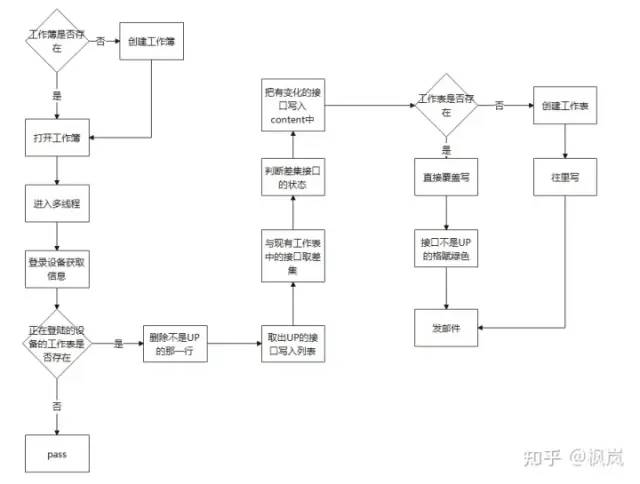
四、测试
首先用四个设备做测试
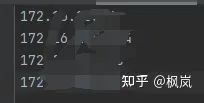
第一次执行成功输出工作簿,下面的工作表示以名字_ip展现
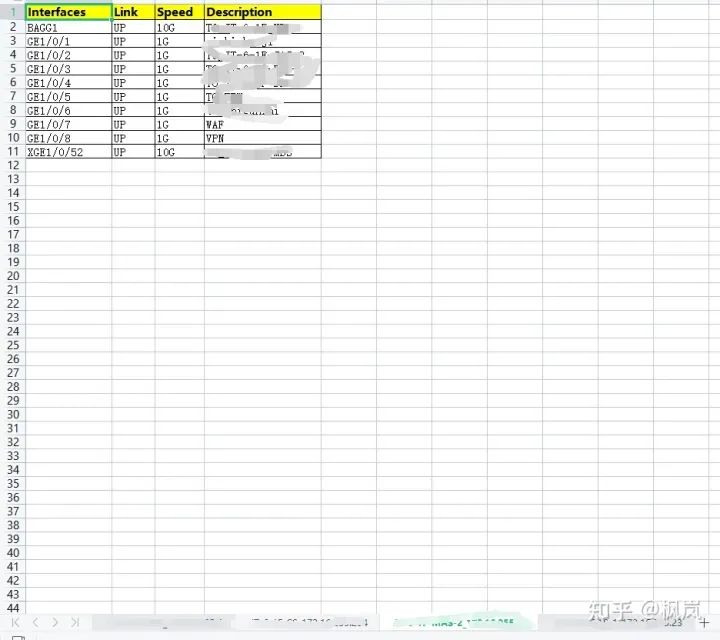
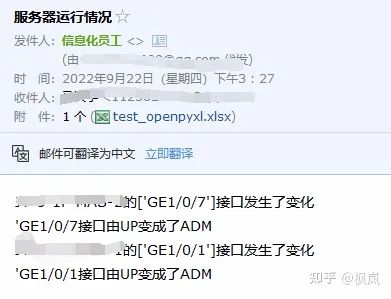

如果此时你就是想把这个接口认为donw掉,然后再执行一次程序,也不会有邮件发出,down掉的接口的那一行也被删除了
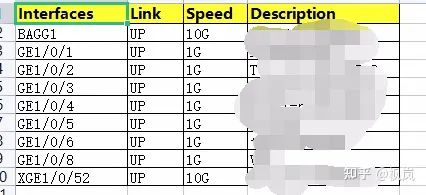
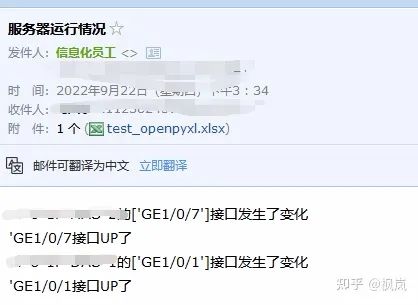
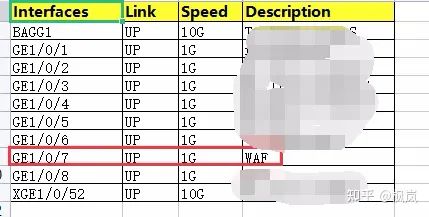
五、总结
最后把这个脚本仍在服务器里,一分钟执行一次,这样一个低成本的监控交换机接口状态变化的脚本就写完了,其实还有点小问题,比如果接口状态不是up了,在输出工作表时,不是UP的那一行就变为了最后一行。
在上大学有一门课叫软件工程,我记得老师教的一句话是”程序开发时要高内聚,低耦合。”然后再看一眼我的代码,真的是有些丑陋,写程序时常常思维不清晰,逻辑不准确。反正,这个脚本在我们现有的网络里能用。
审核编辑 :李倩
-
ADM
+关注
关注
0文章
30浏览量
16028 -
弱电
+关注
关注
0文章
79浏览量
14759 -
python
+关注
关注
56文章
4797浏览量
84776
原文标题:网工Python之路之Netmiko+excle定时检测接口状态
文章出处:【微信号:释然IT杂谈,微信公众号:释然IT杂谈】欢迎添加关注!文章转载请注明出处。
发布评论请先 登录
相关推荐
如何检测HDMI接口是否正常工作
CS1-A磁性开关主要靠什么检测状态使用
接口的控制与状态寄存器什么作用
定时器的工作方式介绍
使用定时器的编码器接口模式,打开定时器的溢出中断,当定时器上溢出和下溢出是,是否都会产生溢出中断?
s7200定时器的五种故障介绍
圆心定位大揭秘!如何快速检测按钮居中状态?
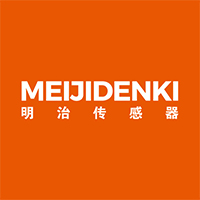




 Netmiko+excle定时检测接口状态
Netmiko+excle定时检测接口状态



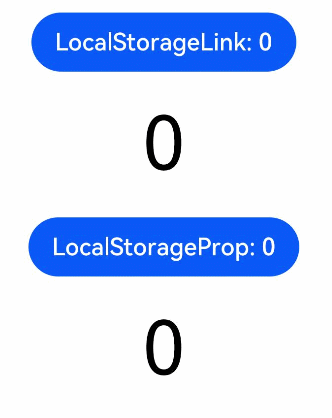










评论